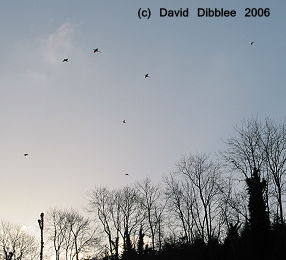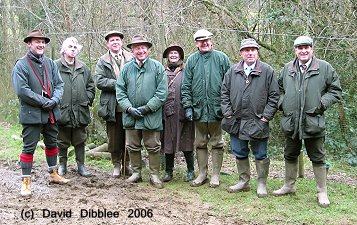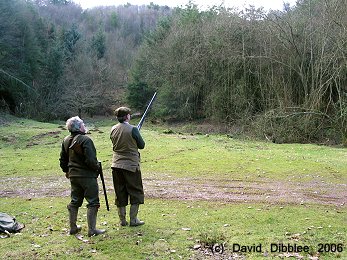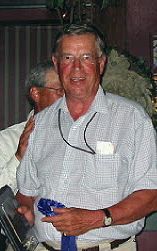
 I’m delighted to have the opportunity to write about my day afield at the Chargot Shoot as a guest of David Powell, the shoot manager . This shoot takes place near Luxborough, Exmoor, in Somerset, England - in season, generally speaking four to five days a week.
"The dogs sat patiently at his side, with pheasants dropping nearby on the hillside, until released to retrieve the fallen birds, which they did in a very polished manner."
With my wife Joanna, I arrived in the UK in mid-January and traveled to Minehead, where we stayed with friends. This was my first visit to Somerset. Though I had lived in England some 45 years ago, I had never attended a driven shoot. I mentioned that I would appreciate having such an opportunity when chatting with the local butcher, Simon David of Gerald David & Sons - Purveyors of Fine Meats throughout Somerset and Devon. Simon said, "Leave that with me – I know just the man," which I did… and he did as promised.
I received a call the very next day from David Powell, manager of the Chargot Shoot. He invited me to come along and observe the next day’s activities. Following his careful directions, I traveled over narrow, hedgerow lined, one-lane roads out from Minehead to, and through, the village of Luxborough. I arrived at about 0830 at Langham Farm. David raises some 2500 sheep and 200 or more cattle together with thousands of pheasants and partridge. The shoot takes place on Mr. John Marshall’s estate as well as on other adjacent farms and on some nearby lands leased from the Forestry Commission.
I was greeted by his under keeper, Jason Massey, then was offered and accepted a cup of tea. Noting my lack of proper footgear, he went off shortly to return with a pair of Chameau boots in my size. My host arrived and introduced himself, and in turn, introduced the guns and their loaders, keepers, some of the beaters and pickers up. With all eight of the guns assembled, each one drew "straws" to determine their "pegs" - or allocated positions at each drive - for the day.
By about 10:00 AM we were off – in Range Rovers, Pathfinders and similar 4x4 vehicles. First, to "Spitfire"… the first drive of the day and one of the finest driven shoots in England. David was in radio communication with his head keeper, Nick Boniface, who was responsible for the beaters and to ensure that they were all in proper positions to effect a drive of highflying birds directed towards the guns.
For those of you who, like me, are not familiar with the practices of a driven shoot, let me explain, using the "Spitfire" as an example. It took place in a steeply sloping gorge-like valley, with the guns and loaders at their "pegs" - perhaps spaced some 30-yards apart in the valley bottom. Each peg position was at a lower elevation than the one in front.
David signaled the start of the drive with a loud whistle. The beaters and their dogs began their beat in the woods, gorse and game crops at the top, driving the pheasants down the axis of the valley. The guns take only incoming high birds, in full flight, often in a strong downwind. A gun has shot well if he drops perhaps two out of ten birds.
David’s whistle announced the end of the drive. We returned to the vehicles where I photographed some of the guns and their loaders.
On we went to the next drive at "Magic Coombe" a short distance away. During this drive, I climbed up into the high hills on one side of the valley with Cedric Boddington who, in the absence of Judy Milton, head picker up at Chargot, was directing the work of the pickers up that day. A wonderful and very knowledgeable man – with two dogs, a springer and a young female black Labrador. The dogs sat patiently at his side, with pheasants dropping nearby on the hillside, until released to retrieve the fallen birds, which they did in a very polished manner. Cedric and I chatted about what was required of the dogs of pickers up, and the obvious pleasure they showed in carrying out their work.
Following this drive, we had a short break to enjoy hot curried parsnip soup and sausages with appropriate libations, all very timely and tasty. The morning ended with yet another drive, at "Chimney", this time on the grounds of the Forestry Commission, followed by lunch.
David kindly invited me to join the guns for lunch at the Lodge at Langham Farm. We had lamb shanks, mashed potatoes, broccoli, carrots and green beans, lemon tart for dessert, followed by an assortment of wonderful cheeses, all courses served with appropriate wines and topped off with a glass of port. The loaders, beaters and the pickers up lunched at the near by pub in Luxborough, the "Royal Oak", one of the best in the region.
There were two more drives after lunch: "Bloddy Awful" and "Parsonage Nouveau". Once again, I saw some marvelous gunning, including the downing of the odd French or red leg partridge quickly identified in flight by David who called out to the nearest gun.
The Chargot Shoot is one of the best in England. On that day, the guns had come from London and other parts of England, the United States and from the Isle of Jersey. David Powell would welcome anyone from either Canada or the USA to the shoot.
|
|
| Bookstore | Bill Fawcett Reviews | Advertise | Classifieds | Resources | Events | Point Standings | Archives | Spaniel Journal | |
|
|
Copyright © Spaniel Journal & L Baughan Webdesign, 2002-2006, all rights reserved worldwide |
|



